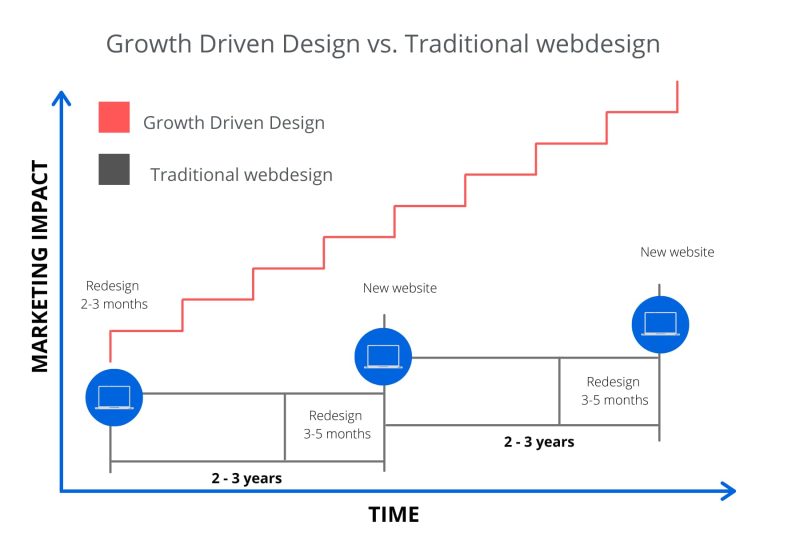What is Growth driven Design?
If you are currently considering a new website or a redesign for your existing one, you may be shuddering from the thought of the last time you went through this. Can you remember how frustrating the process was, and how long you had to wait to see the results? In fact, you may still be waiting to see some ROI. And while you were waiting, you were still stuck with a totally outdated website, or even worse, no website at all. That’s terrible!
The problem is that redesigning or building a website the old way takes a ton of time AND money. Modifications and extra features are never planned or budgeted. And the sad reality is that you as a business owner or marketing manager are stuck with an outdated website from the moment it can finally go live. Not to mention the total standstill of a year or more, while your organization is evolving, but your website isn’t.
So many companies and marketeers launch new websites that are in fact nothing more than expensive digital business cards. But what if we told you that your website could be so much more than that? What if it was a living and evolving system that actually generates revenue for you? Think about it: your website is up and running 24/7, also during holidays, and is constantly gathering data.
So ask yourself: is it smarter to redesign every 2-3 years, or is it better to build something that constantly evolves along with the business itself? This is where Growth Driven Design (or GDD) comes into play.
Growth Driven Design: a definition
In a nutshell: Growth Driven Design is a smarter and agile way to build and modify a website, based on data from actual users. No more building an expensive new website every 2-3 years. Instead, Growth Driven Design offers you a process of continuous updates, improvements and additional features. To do so, it first and foremost lays a good foundation that you can build on.
The result is that you’ll have a good website faster and at a lower cost. And your marketing team has to spend less time on redesigns, so it can do more actual marketing. That allows your organization to focus on those elements of your website that are essential to growing as a business. In other words, it helps your business get more sales faster.

The problem with traditional webdesign
Traditional web design means on average a redesign every 2 to 3 years, often a lot longer. Many companies see their website as a cost, not as an investment. And because of that point of view, the tendency is to keep that cost to a minimum, by keeping their current website live for as long as possible. Unfortunately, that nearly always means that you can only brainstorm your requirements once every 2-3 years. Then follows a period of 3 to 5 months to actually build the website, which usually extends as well. A lot can change during development, as the past few years have shown.
As an organization, you get a website that is already outdate on the go-live date, and on top of that isn’t updated in the slightest for another few years. That simply doesn’t work. It doesn’t get you any ROI. Granted, you’ll get a login too publish some updates yourself, which often doesn’t happen and almost never gives you the right to do more than some text edits. That’s a waste of your hard earned money! The most common problems with traditional web design are:
- large upfront costs with no clear path for growth
- missed deadlines
- long waits for the delivery of your website
- little or no possibility for adjustments after delivery
- the project goes over budget
Advantages of Growth Driven Design
In Growth Driven Design, you’re building a website based on data and informed assumptions. The intention here is to continuously improve your website and add features according to the needs of your organization. The most important advantages of GDD are:
- your financial risk is significantly reduced
- you get a website that is continuously adapted to the needs of your organization
- a customer oriented website focused on delivering a great experience
- sales and marketing alignment
- you stay ahead of your competition
- a website that creates more revenue
With GDD, you launch your website much faster and at a lower cost. Through continuous improvements you also ensure a website that helps generate more revenue. For the sake of completeness, we should add that over its entire lifetime, your website will probably cost a little more in total than with traditional web design, but the added revenue more than makes up for that.
The different phases of Growth Driven Design
If you are planning your new website according to the Growth Driven Design method, then you need to know there are 3 phases in this process:
- The strategy phase
- The launch phase
- The optimization phase
Phase 1: Strategy
Going to your vacation destination blindfolded will get you in trouble very quickly. The same goes for your website: you should start by defining what your goal is and how you want to get there. The strategy phase is the most important one in GDD: this is where you lay the foundation for the success of your new website, and your marketing in general.
In this phase, your goal is to get a view of:
- your targets, SMART defined
- the buyer persona you want to target
- a wish list for your new website
- a detailed journey map
- well-founded assumptions you can start to work with
- insights from existing users
Phase 2: Launching your ' launch pad' website
Once you have defined goals and have a clear picture of what your new website should be able to do, you can launch with what is called a launch pad. In essence, this is a solid basic website on which you can start building everything on your wish list from the previous step. Think of it as a house: you first build solid foundations on which you can build the house of your dreams, floor by floor, room by room.
The purpose of this launch pad website is to be able to start with a better website than the one you have now, without it having to be a finished product. Basically, the idea of Growth Driven Design is that your website is constantly evolving with your business, and thus is never truly finished. A launch pad website:
- lets you see results quickly
- costs a lot less than traditional web design to launch
- is easy to update quickly with content or new features
- allows you to work efficiently and save time
- helps you learn from real users and update your website accordingly
Phase 3: Optimize
Once your launch pad website is live, you can start building on it. To state the obvious: you only need to take the previous step once. Phase 3 is different: continuous updating, adding functionality and so on is a cyclical process that keeps going on. This phase can again be divided into 4 steps:
- Planning: with enough information you can make plans to improve your website, and realize more marketing impact (e.g. attract more visitors, realize more conversions …).
- Building: you build additional elements on the website that can increase your marketing impact, based on your wish list.
- Learning: a crucial step in this phase. Use data from your users to learn what works and what doesn’t, so you can make the right improvements and grow optimally.
- Transfer and repeat: it is also important to transfer what you learned in the previous step to the rest of the team and other stakeholders involved with your website. This way, you get the most out of the changes you schedule.
Your website is not there for yourself, nor is it there for your employees: they already know everything they need to know about your company, they don’t need your website for that. Your website is there for the users (potential customers, clients, partners). The purpose of your website should be to solve a problem or make some aspect of their lives easier. That goes beyond just showing contact information. Growth Driven Design helps your business to do so much more with your website, and to continue to grow your business. It also fits perfectly into your inbound marketing strategy, making your website a lead generation and nurturing machine that works for you. So if you are also going for growth, GDD is definitely for you.
How good is your website?
Use our website grader and get a clear view of your website’s quality in just a few seconds!






